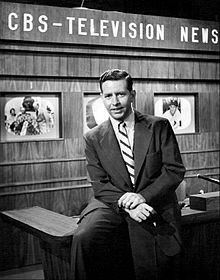Douglas Edwards
Douglas Edwards (July 14, 1917 – October 13, 1990) was an American radio and television newscaster and correspondent who worked for the Columbia Broadcasting System (CBS) for more than four decades.
[8] Using a small crystal radio set that he acquired, Edwards began to monitor each day a wide range of regular broadcasts and special events, a routine made easier by Silver City's high elevation, which allowed him to tune in to distant stations transmitting from Los Angeles, Denver, Philadelphia, Pittsburgh, Atlanta, and elsewhere.
[8] Martin Weil, a staff writer for The Washington Post who compiled a biography on Edwards and wrote the newscaster's 1990 obituary for the newspaper, described the teenager's ongoing fascination with the medium:Radio played an important role in his early years.
[2]At Troy's small, makeshift radio station in 1932, the teenage Edwards was paid $2.50 a week to be a "junior announcer", a disc jockey, and to fill any lapses during broadcasts by reading poetry and even singing occasionally.
Describing those formative days on radio decades later, Edwards said he found the experience thrilling, although he admitted he did not sing well, adding "but I got by, got fan mail, and the ego was nourished.
[6][2] He nevertheless remained intent on working in radio, and between 1935 and 1940, he found employment, first at a small station in Dothan, Alabama; then at WSB in Atlanta; and next, much farther north in Michigan, at WXYZ in Detroit, where he served as a newscaster and announcer.
At the end of the conflict in Europe in May 1945, Edwards was then appointed the network's news bureau chief in Paris and assigned to cover post-war elections in Germany and the start of the Nuremberg trials.
[10] While Edwards served as "anchor" of the programs, that term was actually not used within the context of newscasting, at least not consistently, until 1952, when CBS News chief Sig Mickelson reportedly applied it in describing Walter Cronkite's role in the network's political convention coverage.
Among the many news stories that Edwards covered in those years in the dual role of newscaster-reporter were his trip to the North Pole in 1949, the attempted assassination of Harry S. Truman in November 1950, and the coronation of Elizabeth II in June 1953.
[citation needed] In July 1956, while stationed on a helicopter hovering over the Atlantic Ocean off the coast of Massachusetts, Edwards reported the sinking of the SS Andrea Doria, on-site coverage that received widespread public attention and critical praise.
[12] Despite such efforts and positive reactions to his stories, viewership of Edwards' televised newscasts began to decline by the late 1950s as NBC's new Huntley-Brinkley Report—CBS News' chief competitor—began to attract increasingly larger audiences.
It was also rescheduled to broadcast at 6:30 p.m. instead of its normal 7:30 time slot, and its 15-minute format was expanded to 30 minutes, a change that made it the first half-hour weeknight news show on American television.
[18] Directed by David Ossman, a member of the Firesign Theater troupe, the NPR production aired exactly 50 years after Welles' original radio presentation.

